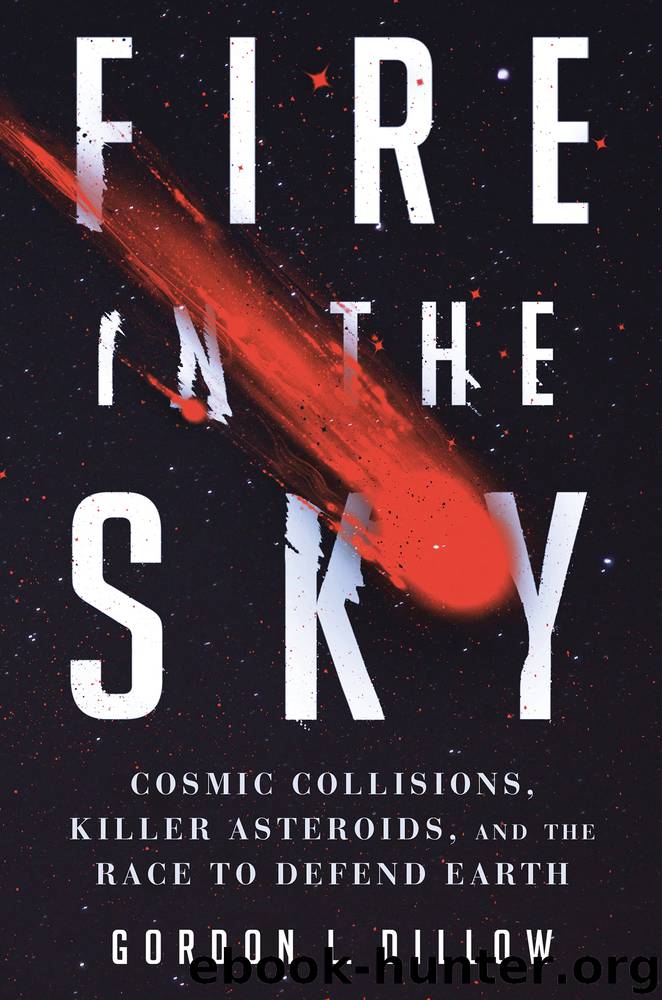Fire in the Sky: Cosmic Collisions, Killer Asteroids, and the Race to Defend Earth by Gordon L. Dillow

Author:Gordon L. Dillow [Dillow, Gordon L.]
Language: eng
Format: epub
ISBN: 9781501187742
Google: u7GWDwAAQBAJ
Amazon: 1501187740
Goodreads: 42202114
Publisher: Scribner
Published: 2019-06-03T23:00:00+00:00
Again, the Catalina Sky Survey isn’t the only Near-Earth Object search and track program out there. As I mentioned earlier, there’s also Pan-STARRS, ATLAS, Spacewatch, NEOWISE, and others that are on the way.
Having a lot of NEO surveys operating at once isn’t an unnecessary redundancy. Some of the surveys are better equipped to find certain kinds of asteroids than others, some concentrate on follow-up observations, and each survey is limited by its location to what part of the sky is visible on any given night. All of the active NEO surveys cooperate and share information, so it’s a group effort—although they all keep a close eye on their individual stats. Currently the Catalina Sky Survey is the leader, having discovered almost half of all known NEOs over the past two decades. Although the newer Pan-STARRS in Hawaii briefly took the lead in yearly NEO discoveries, Catalina was back on top in 2017 with nearly a thousand new NEOs discovered.
“It’s not really a competition,” says Catalina Sky Survey director Eric Christensen, a tall, soft-spoken 40-year-old who’s been in the asteroid hunting business for much of the past two decades. But after noting the disbelieving look on my face he smiles and cheerfully admits that, okay, yeah, it is a competition—“a friendly competition.” It’s like being in a softball league: You can like and respect the people on the other team, but you still want to score more runs than they do.
Collectively the various NEO sky surveys have racked up some impressive discovery numbers over the past two decades. In 1998 only 450 Near-Earth Objects had been discovered; as of October 2018, the number of known NEOs was at 19,000 and counting, with about 1,900 of them designated as potentially hazardous objects, meaning they’re big enough and come close enough to Earth to pose a future threat. As for the non-Earth-threatening main belt asteroids, in 1998 fewer than 10,000 had been discovered; today about 750,000 such asteroids have been identified.
That’s a lot of asteroids. But compared with the total number of asteroids out there—millions and millions of them, large and small—we’ve barely scratched the surface.
The asteroid hunters have made excellent progress in spotting the larger Near-Earth asteroids. You’ll recall that in 1998 Congress directed NASA to identify at least 90 percent of all NEOs bigger than one kilometer (a little over half a mile) across, and to do it within a decade. The thinking was that those large asteroids (or comets) are capable of destroying civilization, if not human life itself, and thus pose the greatest danger.
The asteroid hunters have exceeded that goal. Today about 900 NEOs bigger than a half-mile across have been identified, representing about 95 percent of the estimated large NEO population. And it turns out that none of those large, potentially Earth-busting asteroids are in orbits that will put them on a collision course with Earth, at least not within the next century and probably even longer. Of course, that still leaves 5 percent of the suspected large
Download
This site does not store any files on its server. We only index and link to content provided by other sites. Please contact the content providers to delete copyright contents if any and email us, we'll remove relevant links or contents immediately.
Sapiens: A Brief History of Humankind by Yuval Noah Harari(14248)
The Tidewater Tales by John Barth(12608)
Mastermind: How to Think Like Sherlock Holmes by Maria Konnikova(7225)
Do No Harm Stories of Life, Death and Brain Surgery by Henry Marsh(6887)
The Thirst by Nesbo Jo(6826)
Why We Sleep: Unlocking the Power of Sleep and Dreams by Matthew Walker(6618)
Life 3.0: Being Human in the Age of Artificial Intelligence by Tegmark Max(5474)
Sapiens by Yuval Noah Harari(5293)
The Longevity Diet by Valter Longo(5017)
The Body: A Guide for Occupants by Bill Bryson(4974)
The Rules Do Not Apply by Ariel Levy(4852)
The Immortal Life of Henrietta Lacks by Rebecca Skloot(4525)
Animal Frequency by Melissa Alvarez(4394)
Why We Sleep by Matthew Walker(4359)
The Hacking of the American Mind by Robert H. Lustig(4318)
Yoga Anatomy by Kaminoff Leslie(4303)
All Creatures Great and Small by James Herriot(4231)
Double Down (Diary of a Wimpy Kid Book 11) by Jeff Kinney(4206)
Barron's AP Biology by Goldberg M.S. Deborah T(4096)
